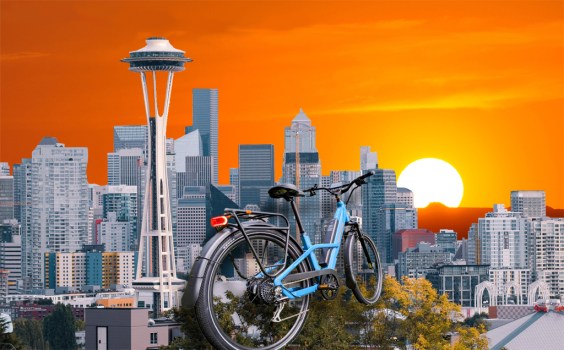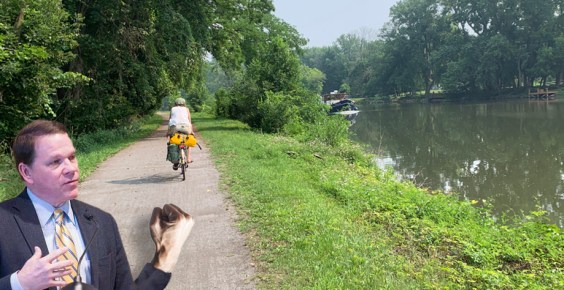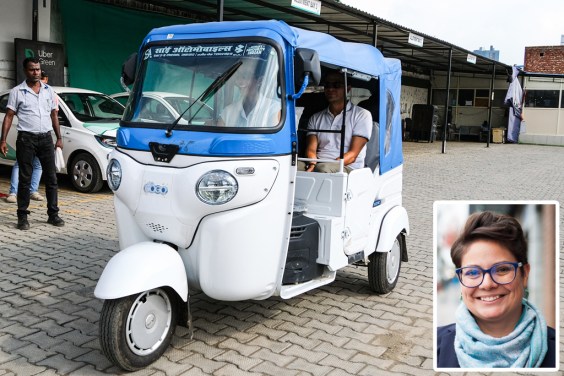What makes a city great? According to Jeff Speck, the secret sauce is, quite simply, walking. If your city is a good place to walk -- that is, walking is safe, comfortable, interesting, and useful -- everything else will fall into place.
In Walkable City, his talked-about manifesto about healthy urban places, Speck lays out a simple formula for any city to become a pedestrian haven. "Putting cars in their place," "mixing uses," "getting parking right," and supporting transit and cycling are a few of the 10 principles, he says, that separate the successful cities from the rest.
A planner and urban design consultant, Speck has a few other books under his belt. In 2000, he co-authored Suburban Nation with Andres Duany and Elizabeth Plater-Zyberk, and he also co-wrote the recently released Smart Growth Manual with Duany and Mike Lydon. Meanwhile, Speck has served as the director of design for the National Endowment for the Arts and headed the Mayors' Institute on City Design.
In Walkable City, he lays out a powerful argument, supported by careful research and highly-Tweetable facts, that fostering a culture of walking should be a central aim of every American city.
If you're a professional planner or advocate, Walkable City is a new, essential reference. If you're new to the subject, there's no better introduction.
Streetsblog reached Speck this morning for an interview. Here's what he had to say...
Angie Schmitt: You’ve taken the broad concept of civic health and boiled it down to this one act: walking. Can you talk a little about why this one activity is so important? How did you come to that conclusion?
Jeff Speck: I came to it very indirectly. I am a designer. I am a city planer. I was never focused on walking in any way, from a health perspective or a recreational perspective.
But then I started working with a lot of mayors. I oversaw the Mayors' Institute on City Design for four years. Every two months, eight mayors and eight designers would meet. Each mayor would bring their top city planning challenge.
Listening to mayor after mayor and how they explained their idea of a successful city, it became very clear that both the best measure of a thriving place and perhaps the best contributor to a thriving place was street life: walkability. Being successful in walkablity is really nothing less than providing street life. In our age of digital connectedness, I think for a while people forgot how important it was to have a public realm where we come to gather physically. That is still in our DNA. We need that.
It became clear to me that solving the walkability problem ended up addressing all their other concerns as well. It was not a strategic choice, to reframe this argument under the realm of walkability, but I have to say it may finally be the outfit that allows this concept to sell. We can clothe it in other terms like New Urbanism, which scares conservatives, and neo-traditionalism, which scares liberals. But no one doesn’t like walking.
AS: What is the biggest mistake cities make?
JS: I’ve repeated it so much I hate to tell you the same thing, but it’s the honest truth. The biggest mistake cities make is to allow themselves to effectively be designed by their director of public works. The director of public works, he or she is making decisions every single day about the width of streets, the presence of parking, the question of bike lanes. And he’s doing it in response to the complaints he’s hearing. But if you satisfy those complaints you wreck the city.
A typical public works director doesn’t think about "What kind of city do we want to be?" They think about what people complain about, and it’s almost always traffic and parking.
The one thing we’ve learned without any doubt, is the more room you give the car the more room they will take and that will wreck cities. Optimizing any of these practical considerations -- sewers, parking, vehicle capacity -- almost always makes a city less walkable.
AS: What do the effective cities do instead?
JS: In more effective cities there’s a mayor who sees that he’s more or less the chief designer of the city. Charleston’s mayor, Joseph Riley, woke up one morning, slapped his head and said, "Oh my God, I am the chief designer of my city. I need to start making decisions that make my city more beautiful and functional in a more holistic way."
Cities need specialists that help define what make them a great city. Is it going to make you a great city having an 18 minute commute versus a 20 minute commute? Or is it going to make you a great city to have a smaller carbon footprint and more transportation choices?
Those cities that recognize that they’re not generating the economic activity that they could because they’re not generating a street life and their population is sick, overweight, because they’re not getting enough exercise, they’re not getting a useful walk -- those are the cities that are succeeding. If they decide that those are the objectives: economic health, public health, and environmental sustainability – [they] all mandate a city which is walkable city.
AS: You single out smaller, “more normal” cities as sort of the next frontier of this movement, as opposed to livability stars like New York and San Francisco. How do you reach these less progressive places?
JS: There is a lot of data from New York and San Francisco in it, but this book is firmly directed at the Clevelands, the Las Vegases, the Dallases, the Cedar Rapids. The cities that, if they’ve figured it out, they’re not showing it.
My book is part of it but it can’t be just me. My small firm only does so much work, now with my book out I’m doing much less [planning] work. I think it’s much more important to spread the message than to make more examples.
I lecture to the largest possible audience and then generally someone from the city council says, "We need you to help us." But that is not a strategy for fixing our country. There will be, and there are, dozens of practitioners that will hopefully take this to their cities. This book will hopefully increase the demand for them, for their work as well.
There are probably 500 cities in America that have one-way streets through their downtown or a four-lane, two-way road that could get a road diet. They just need to come to understand this discussion.







